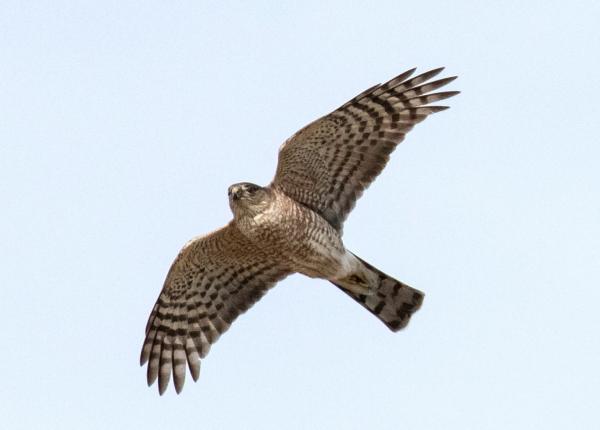Did you know?
- The Sharp-shinned Hawk’s prey usually is taken to a special location near the nest to be plucked of its feathers or fur. This perch is referred to as a plucking post or butcher’s block.
- All North American accipiters have red eyes as adults.
- Sharp-shinned Hawks, sometimes colloquially referred to as "Sharpies," are the smallest hawks in North America.
How The Peregrine Fund is helping
The Peregrine Fund is working to protect the Puerto Rican Sharp-shinned Hawk, an endangered subspecies that is only found on the island of Puerto Rico. Loss of their forest habitat has had a devastating effect on this species.
Where they live
Sharp-shinned Hawks are found throughout North America, Central America, and South America, as well as some Caribbean islands such as Dominican Republic and Puerto Rico. As you might expect, individuals that live in the northernmost part of the range face much harsher winters than individuals living south. To compensate for this, some of these hawks will migrate during the colder, winter months. Some travel as far south as Panama, while others simply move to lower elevations.
As a species, the Sharp-shinned Hawk isn't too picky when it comes to choosing where to live. It can be found in lowland habitats as well as high montane forests. Some individuals prefer coniferous forests, while those living in tropical areas are often found in scrubby second growth, hedgerows, agricultural fields, coffee plantations, and even suburban areas. In Cuba, Sharp-shinned Hawks might be seen in forests at moderate to high elevations, while those in Dominican Republic most often are found in mature forests in interior hills and mountains, most often in pine, shade coffee and broadleafed forests.
What they do
When you first heard this bird's name - Sharp-shinned Hawk - you may have asked yourself a number of different questions including 1) Do birds have shins? 2) Just how sharp are the Sharp-shinned Hawk's shins? and 3) Who is going around feeling birds' shins to determine just how sharp or unsharp they are? Sharp-shinned Hawks have been given this name because they have a sharp ridge on the leading edges of their legs.
These accipiters are strikingly beautiful. The adults have dark gray backs and reddish-orange bars that run horizontally on their breasts. They have long legs and long tails, the latter of which is marked by wide bands.
May soar to moderate heights, but not for detecting prey.
Why they need our help
In the early 1900s, Sharp-shinned Hawks were hunted extensively during migration periods, and in the middle part of the century the population further declined as the effects of pesticides, such as DDT, took their toll. Since then, their numbers have rebounded to near historic levels in most parts of their range. However, there is considerable concern for birds that travel to Central and South America or eat prey from these countries because many of the harmful pesticides banned in North America are still used there. Though common in many places, they are threatened or endangered on several Caribbean islands.
What they eat
Up to 90 percent of their diet consists of small birds, but they also may take small mammals, frogs, lizards, and insects. They rely on the element of surprise to locate their prey and use a short burst of flight to chase it down. They are adept at flying through thick vegetation, which they use as cover when pursuing prey.
Nest, eggs and young
A stick nest lined with bark and greenery is usually built each year in a dense stand of trees. Their eggs were once prized by egg collectors for their variability in color and pattern, frequently showing light brown blotches against a dull white background. The female lays 2–5 eggs that are incubated for 30–32 days. The young fledge 3–4 weeks later and may be able to raise their own chicks the following year.
Idaho Connection
The Sharp-shinned Hawk is found throughout much of Idaho. They can be found in forested habitats throughout the state. In winter, you might stumble upon a Sharp-shinned Hawk in your backyard, as they have learned to depend on backyard bird feeders—or rather, the birds they attract—for food, especially during the colder months of the year.
Sharp-shinned Hawk and The World Center for Birds of Prey
The World Center for Birds of Prey offers fun ways to learn about birds of prey. Interactive activities, tours, interesting videos and a children's room with activities from coloring sheets to quizzes to costumes are all available for our guests. We also have knowledgeable, on-site staff to answer any questions you may have.
Research Resources
- Sharp-shinned Hawk in Global Raptor Information Network
- https://www.hawkmountain.org/raptors/sharp-shinned-hawk#:~:text=The%20sharpshin%20derives%20its%20name,most%20easily%20observed%20during%20migration.









